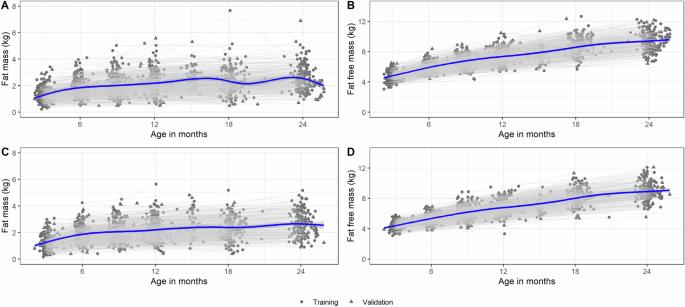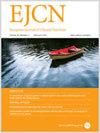3 至 24 个月婴儿身体成分的人体测量预测模型:一项多中心国际研究。
IF 3.3
3区 医学
Q2 NUTRITION & DIETETICS
引用次数: 0
摘要
背景:准确评估婴儿期的身体成分是早期发育的重要标志。本研究旨在建立人体测量模型,以预测来自不同社会经济环境和种族群体的 3-24 个月大婴儿的身体成分:方法:这是一项观察性、纵向、前瞻性、多国研究,研究对象为 3 到 24 个月大的婴儿,使用氘稀释法(DD)和人体测量法每隔三个月对婴儿的身体成分进行评估。研究采用线性混合模型,以身长(米)、身长比体重(千克/米)、肱三头肌和肩胛下皮褶以及南亚人种为变量,生成性别特异性脂肪量(FM)和无脂肪量(FFM)预测方程。研究样本包括来自巴西、巴基斯坦、南非和斯里兰卡的 1896 个训练数据集(来自 310 个女孩的 942 个测量数据)和 941 个验证数据集(来自 154 个女孩的 441 个测量数据),年龄为 3-24 个月。外部验证组(测试)包括来自南非、澳大利亚和印度的 250 名 3-6 个月婴儿(185 名来自 124 名女孩)的 349 次测量结果:结果:制定了三个年龄组(3-9 个月;10-18 个月;19-24 个月)的性别方程,并在同一人群中进行了验证和外部验证。在评估男孩和女孩的 FM 和 FFM 时,训练、验证和测试数据的均方根误差(RMSE)相似。在预测 FM 时,验证数据的均方根误差和平均绝对百分比误差(MAPE)均高于测试数据,但在评估 FFM 时,验证数据的这两项指标均低于测试数据。与澳大利亚(M/F-0.51/0.33 kg)和印度(M/F-0.77/0.80 kg)相比,南非测试数据(M/F-0.46/0.45 kg)的RMSE与FFM评估的验证数据显示出良好的一致性:结论:基于人体测量学的FFM预测方程可提供可接受的结果。基于相似人群开发的方程进行评估比基于不同人群开发的方程更适用。本文章由计算机程序翻译,如有差异,请以英文原文为准。

Anthropometric prediction models of body composition in 3 to 24month old infants: a multicenter international study
Accurate assessment of body composition during infancy is an important marker of early growth. This study aimed to develop anthropometric models to predict body composition in 3–24-month-old infants from diverse socioeconomic settings and ethnic groups. An observational, longitudinal, prospective, multi-country study of infants from 3 to 24 months with body composition assessed at three monthly intervals using deuterium dilution (DD) and anthropometry. Linear mixed modelling was utilized to generate sex-specific fat mass (FM) and fat-free mass (FFM) prediction equations, using length(m), weight-for-length (kg/m), triceps and subscapular skinfolds and South Asian ethnicity as variables. The study sample consisted of 1896 (942 measurements from 310 girls) training data sets, 941 (441 measurements from 154 girls) validation data sets of 3–24 months from Brazil, Pakistan, South Africa and Sri Lanka. The external validation group (test) comprised 349 measurements from 250 (185 from 124 girls) infants 3–6 months of age from South Africa, Australia and India. Sex-specific equations for three age categories (3–9 months; 10–18 months; 19–24 months) were developed, validated on same population and externally validated. Root mean squared error (RMSE) was similar between training, validation and test data for assessment of FM and FFM in boys and in girls. RMSPE and mean absolute percentage error (MAPE) were higher in validation compared to test data for predicting FM, however, in the assessment of FFM, both measures were lower in validation data. RMSE for test data from South Africa (M/F−0.46/0.45 kg) showed good agreement with validation data for assessment of FFM compared to Australia (M/F−0.51/0.33 kg) and India(M/F−0.77/0.80 kg). Anthropometry-based FFM prediction equations provide acceptable results. Assessments based on equations developed on similar populations are more applicable than those developed from a different population.
求助全文
通过发布文献求助,成功后即可免费获取论文全文。
去求助
来源期刊
CiteScore
10.60
自引率
2.10%
发文量
189
审稿时长
3-6 weeks
期刊介绍:
The European Journal of Clinical Nutrition (EJCN) is an international, peer-reviewed journal covering all aspects of human and clinical nutrition. The journal welcomes original research, reviews, case reports and brief communications based on clinical, metabolic and epidemiological studies that describe methodologies, mechanisms, associations and benefits of nutritional interventions for clinical disease and health promotion.
Topics of interest include but are not limited to:
Nutrition and Health (including climate and ecological aspects)
Metabolism & Metabolomics
Genomics and personalized strategies in nutrition
Nutrition during the early life cycle
Health issues and nutrition in the elderly
Phenotyping in clinical nutrition
Nutrition in acute and chronic diseases
The double burden of ''malnutrition'': Under-nutrition and Obesity
Prevention of Non Communicable Diseases (NCD)

 求助内容:
求助内容: 应助结果提醒方式:
应助结果提醒方式:


